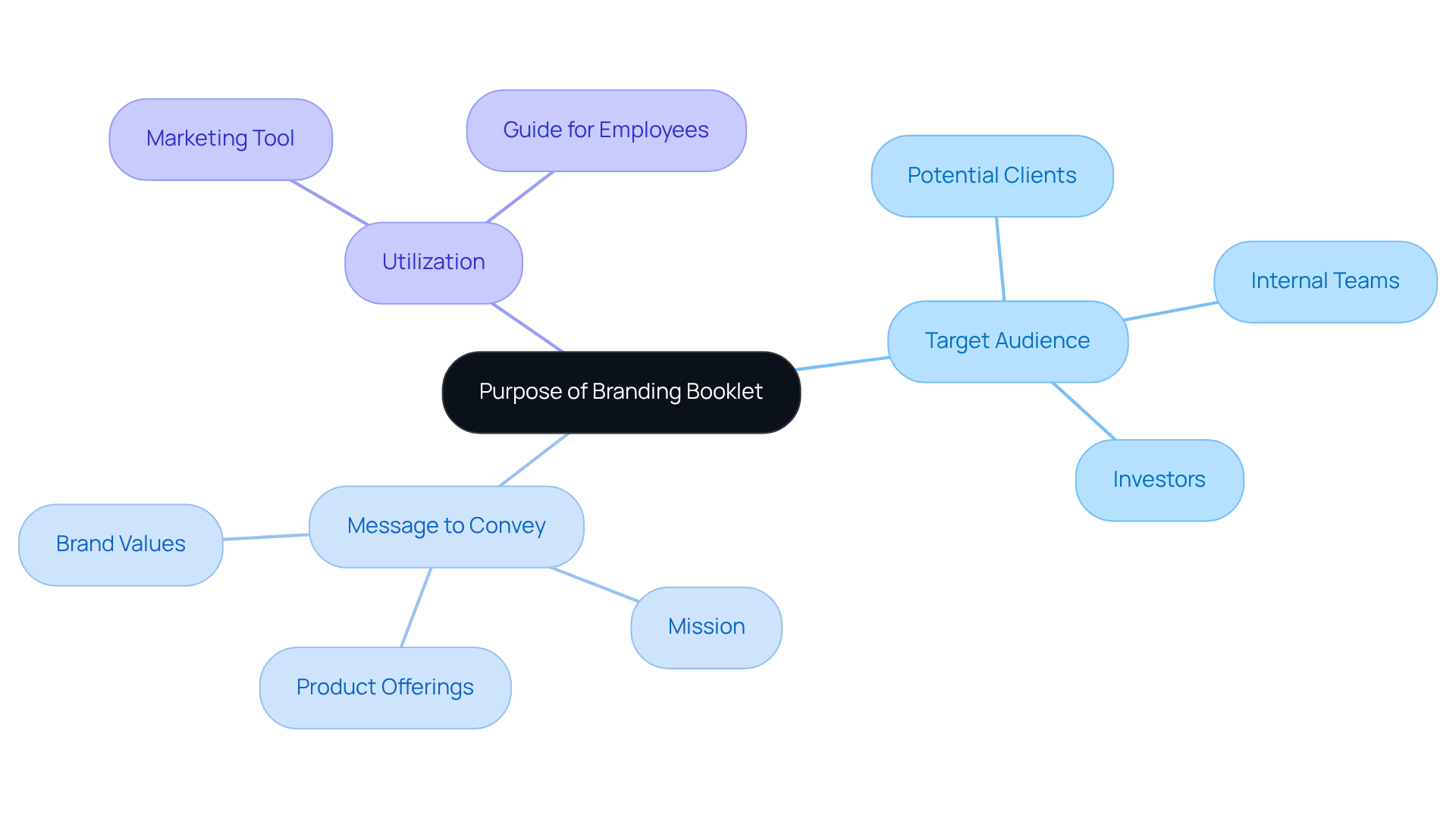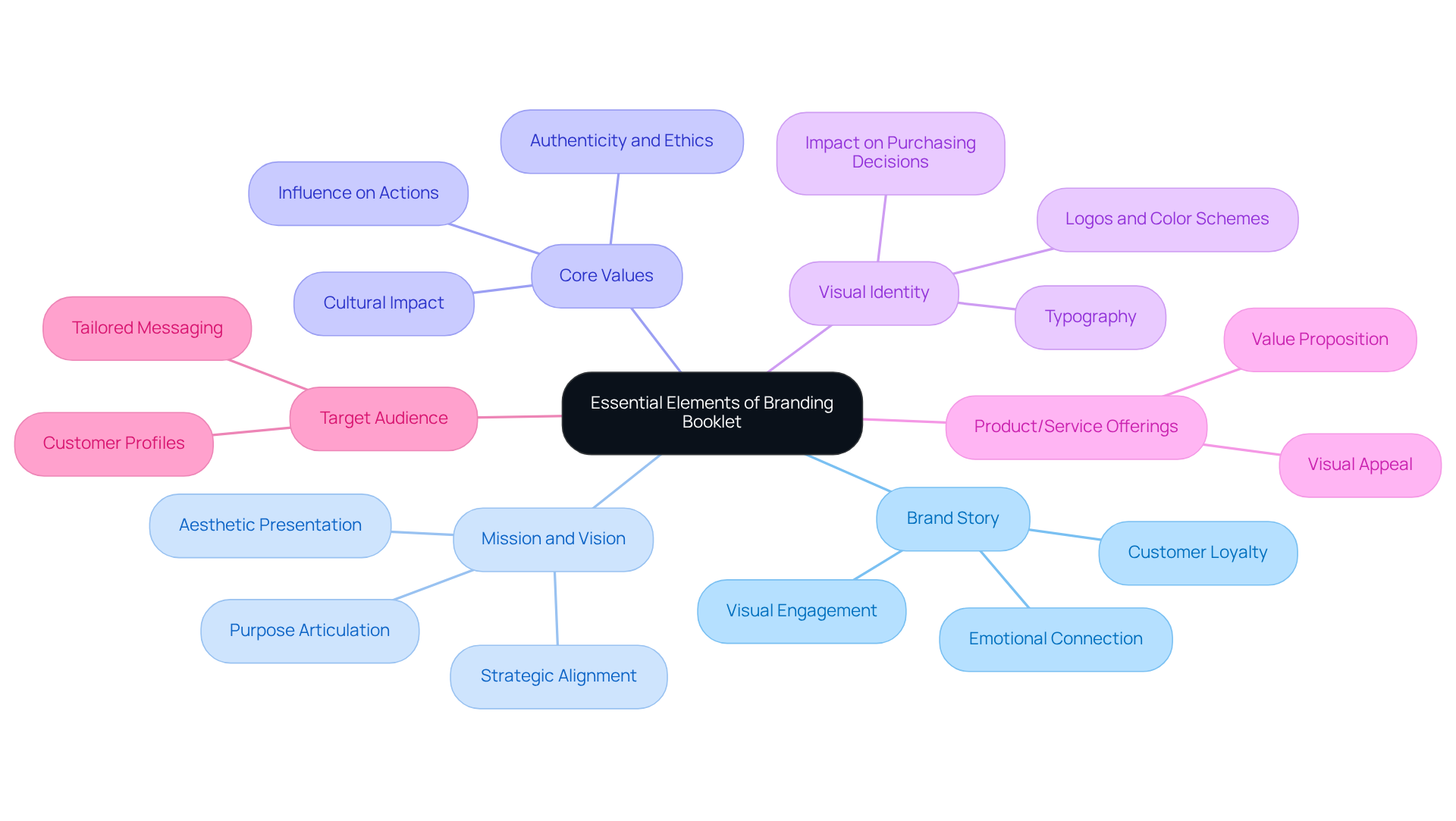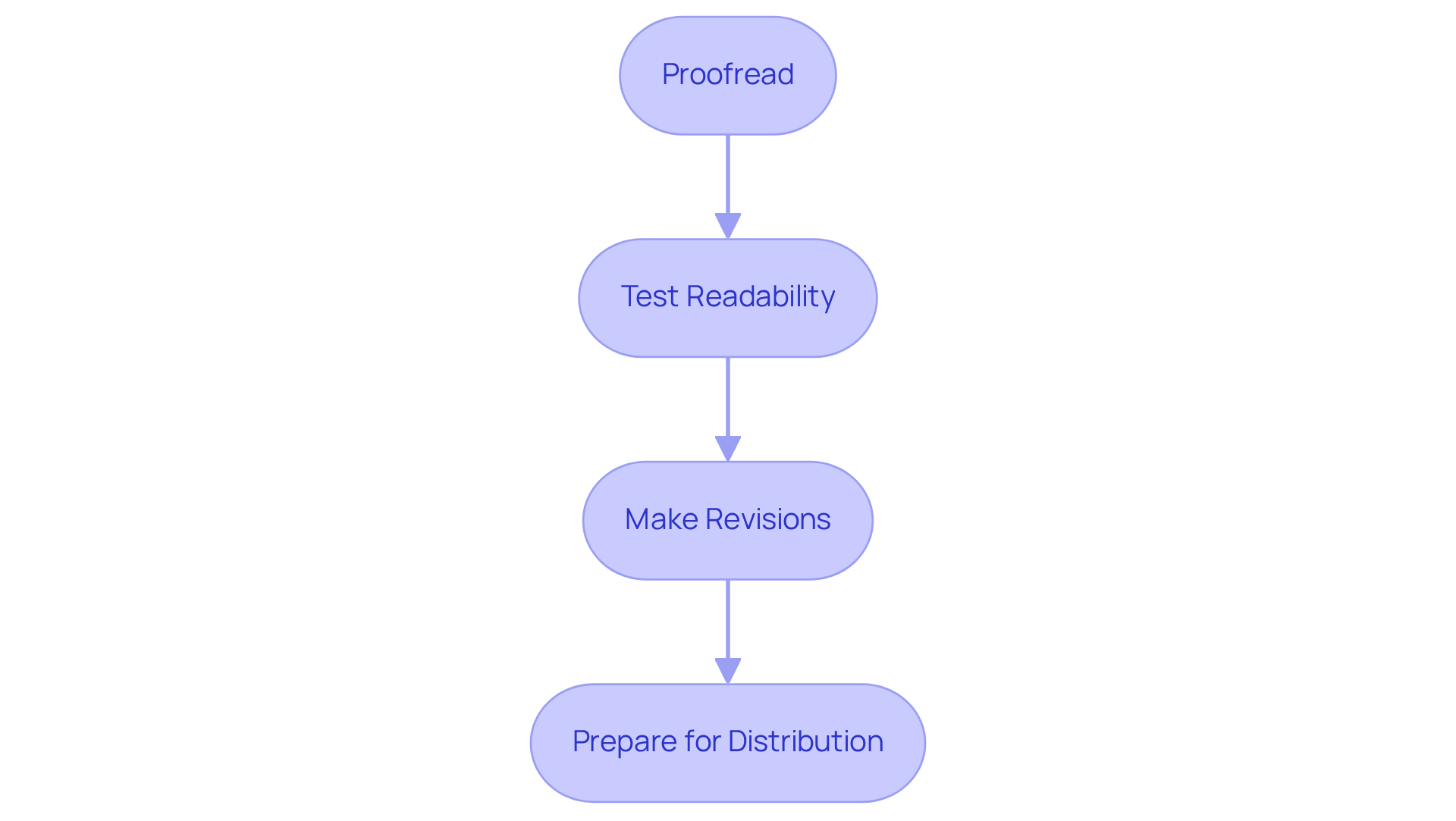Overview
Creating an effective branding booklet can feel overwhelming, especially for tech startup founders who are juggling numerous responsibilities. The challenge lies in clearly defining the booklet's purpose and ensuring that it resonates with the target audience. Without a structured approach, you may find yourself lost in the details, leading to a presentation that lacks clarity and impact.
Imagine pouring your heart into your startup, only to have your branding fail to communicate your vision. This can lead to missed opportunities and a disconnect with potential customers. It’s essential to identify key elements like your brand story and visual identity, as these are the cornerstones of a compelling presentation.
The good news is that there’s a nurturing way to tackle this challenge. By focusing on a structured approach, you can design your branding booklet with intention. Pay attention to layout and typography, ensuring that every element works harmoniously to reflect your brand’s essence. Take the time to review your content for clarity and consistency, creating a professional presentation that truly resonates with your audience.
Remember, you’re not alone in this journey. Many have faced similar struggles, and with the right steps, you can create a branding booklet that not only showcases your startup but also connects with your audience on a deeper level. Let’s embrace this process together, transforming your vision into a reality that speaks to those you aim to serve.
Introduction
Creating a branding booklet is more than just a design task; it’s a strategic journey that shapes how your brand is perceived in a bustling marketplace. Many founders face the challenge of standing out amidst fierce competition, which can feel overwhelming. By establishing a clear purpose and weaving in essential elements like:
- Brand stories
- Core values
- A visually appealing identity
you can craft a powerful tool that truly resonates with your target audience. Yet, with so many components to consider, it’s natural to wonder: how can you ensure that the final product not only communicates effectively but also engages and inspires trust? This guide is here to walk you through the vital steps to developing an effective branding booklet that not only elevates your brand presence but also fosters meaningful connections. Together, we can navigate this process and create something exceptional.
Define the Purpose of Your Branding Booklet
To begin, it's essential to clarify the main goal of your marketing guide. Consider the following questions:
- Who is your target audience? (e.g., potential clients, internal teams, investors)
- What message do you wish to convey? (e.g., brand values, mission, product offerings)
- How will the booklet be utilized? (e.g., as a marketing tool, a guide for employees)
Once you have a clear understanding of these aspects, craft a concise statement that encapsulates the purpose of your branding booklet. This statement will serve as your guiding light throughout the content creation and design process. Remember the insightful words of Krunal Vaghasiya, a marketing tech expert: "A company is more than just its logo; it embodies the company’s core values and its mission." Furthermore, it's important to recognize that 81% of consumers require trust in a company before considering a purchase. This statistic underscores the significance of clearly identifying your target audience and goals. By aligning your promotional guide with these insights, you can develop a more effective tool that truly resonates with your audience, fostering a deeper connection and understanding.

Identify Essential Elements to Include
Creating an engaging branding booklet can feel overwhelming, particularly when you aim for it to resonate deeply with your audience and reflect your unique identity. It’s essential to include several key elements that not only capture attention but also foster a genuine connection. Let’s explore these fundamental components together:
- Brand Story: Your brand's narrative is more than just a tale; it’s the heart of your identity. It outlines your origins and evolution, establishing an emotional connection with your audience. A compelling story can significantly enhance customer loyalty, fostering trust and relatability. At RNO1, we believe that this story should be visually compelling, making it even more engaging for consumers.
- Mission and Vision: Clearly defined statements that articulate your organization's purpose and aspirations are crucial. These elements guide your strategic decisions and help align your team with your overarching goals. RNO1 emphasizes aesthetics in these statements, ensuring they are not only clear but also visually appealing, reflecting your brand’s essence.
- Core Values: The principles that influence your organization's actions and decisions are vital. These values shape your internal culture and resonate with consumers who prioritize authenticity and ethical practices. RNO1 integrates design into these values, presenting them in a way that is both impactful and memorable, reinforcing your commitment to integrity.
- Visual Identity: Your logos, color schemes, typography, and visuals are essential for recognition. RNO1’s design-focused approach ensures that these elements are not only functional but also aesthetically pleasing, enhancing brand visibility. Did you know that a well-defined visual identity can influence purchasing decisions by up to 85%? It’s essential for making a lasting impression.
- Product/Service Offerings: A concise overview of what you provide is necessary to ensure that potential customers understand your value proposition. RNO1’s creative philosophy helps showcase these offerings in a visually appealing way, enhancing their attractiveness to prospective clients.
- Target Audience: Understanding your ideal customers is vital for tailoring your messaging and marketing strategies effectively. RNO1 employs aesthetics to create profiles that connect with these audiences, ensuring that your identity communicates directly to their needs.
By organizing these elements in a logical sequence, you can create a cohesive narrative that engages readers and reinforces the identity presented in your branding booklet. This organized method, combined with a strong focus on aesthetics, not only improves clarity but also prepares you for the next phases in crafting a comprehensive marketing strategy. Remember, you’re not alone in this journey; RNO1 is here to support you every step of the way.

Design Your Branding Booklet Effectively
When creating your branding booklet, it’s important to consider some essential elements that can make a significant difference in your journey.
-
Layout: A clean and organized layout is crucial for guiding the reader's eye through the content. Think about how a well-structured layout can ease the reader's experience, making them feel welcomed and engaged. Utilizing grids can help maintain alignment and consistency, ensuring that each page flows seamlessly into the next. Research indicates that effective layout design can significantly enhance reader engagement, making it vital to prioritize this aspect. Remember, a thoughtful layout in the branding booklet can transform how your audience connects with your brand.
-
Typography: Choosing fonts that represent your identity is essential. Are your choices reflecting the heart of your brand? Ensure readability by selecting appropriate sizes and weights; studies show that well-chosen typography can improve user experience and retention. Design professionals emphasize that typography should not only be aesthetically pleasing but also functional, enhancing the overall clarity of your message. Your typography can convey a lot about the personality reflected in your branding booklet.
-
Color Scheme: Your color selections should correspond with your identity. Opt for contrasting colors for text and background to enhance readability. Think about how color can evoke emotions and perceptions; statistics reveal that color can influence consumer perception, with 39% of users identifying it as a critical visual element on a site. Choosing the right colors can create a welcoming atmosphere for your audience.
-
Imagery: Incorporate high-quality images and graphics that complement the text. Relevant visuals can significantly boost engagement, with posts containing images receiving 94% more views than those without. Consider how imagery can tell your story and resonate with your target audience. Ensure that all imagery supports the overall message and connects with your audience's aspirations.
Utilizing design software or templates can assist you in creating a professional-looking publication. Consistency with the branding booklet's visual identity is paramount, as it reinforces recognition and trust among your audience. Remember, every design choice you make is an opportunity to connect with your audience on a deeper level.

Review and Refine Your Branding Booklet
Creating a compelling promotional guide can feel overwhelming, and it's essential to approach this task with care. Here’s a supportive framework to help you navigate the process:
-
Proofread: Take a moment to carefully check for any spelling and grammatical errors. Tools like Grammarly can be your ally in this journey, helping ensure that your document reflects professionalism and attention to detail. Seek feedback by sharing your branding booklet with colleagues or trusted individuals to gain diverse perspectives. Remember, feedback is not just a step; it’s a crucial part of the process. As David Aaker wisely notes, branding infuses spirit and meaning into a product. Insights from others can truly enhance this essence. Consider that customers often need to see your identity at least seven times before they feel ready to make a purchase decision. This highlights the importance of clear communication.
-
Test Readability: It’s vital to ensure that your content is accessible and easy to understand. Have someone unfamiliar with your brand review the branding booklet to give feedback on clarity and engagement. Effective marketing leaves a lasting impression, as noted by Huddle Creative, and thoughtful revisions can significantly enhance this impact.
-
Make Revisions: Based on the feedback you receive, take the time to adjust the content and design for greater effectiveness. Focusing on brand consistency can boost revenue by 10-20%, underscoring the importance of a thorough review process in achieving a successful brand identity.
Once you feel satisfied with the final version of the branding booklet, prepare it for distribution in both print and digital formats, ensuring it aligns with the initial purpose defined in your branding strategy. Remember, you’re not alone in this process; every step you take brings you closer to connecting with your audience.

Conclusion
Creating an effective branding booklet can feel daunting, yet it is a vital step toward enhancing a brand's visibility and forging meaningful connections with its audience. When a brand takes the time to define its purpose clearly, incorporate essential elements, design thoughtfully, and refine the final product, it transforms a simple booklet into a powerful tool for communicating its identity and values.
Throughout this journey, we’ve shared insights on crafting a branding booklet that truly resonates with its intended audience. Understanding your target audience and goals is crucial; it’s about more than just aesthetics. Including vital components such as:
- A compelling brand story
- Mission and vision statements
- Core values
- A well-defined visual identity
Moreover, paying attention to design elements like layout, typography, color schemes, and imagery can significantly engage readers and enhance brand recognition.
Ultimately, creating a branding booklet is not merely a task; it’s an opportunity to deepen connections with consumers and stakeholders alike. By following the outlined steps and embracing feedback, you can ensure that your messaging is clear, impactful, and reflective of your core values. Investing time and effort into this process can yield long-lasting benefits, fostering trust and loyalty that drive business success. Remember, you are not alone in this endeavor; together, we can navigate the path to a stronger brand identity.
Frequently Asked Questions
What is the first step in creating a branding booklet?
The first step is to define the purpose of your branding booklet by clarifying the main goal and considering questions such as who your target audience is, what message you wish to convey, and how the booklet will be utilized.
Who should be considered as the target audience for a branding booklet?
The target audience can include potential clients, internal teams, and investors.
What key message should a branding booklet convey?
A branding booklet should convey the brand's values, mission, and product offerings.
How can a branding booklet be utilized?
It can be utilized as a marketing tool or as a guide for employees.
Why is it important to clearly identify the target audience and goals for a branding booklet?
Clearly identifying the target audience and goals is crucial because 81% of consumers require trust in a company before considering a purchase. This understanding helps in creating a more effective tool that resonates with the audience.
What should guide the content creation and design process of a branding booklet?
A concise statement that encapsulates the purpose of the branding booklet should guide the content creation and design process.




